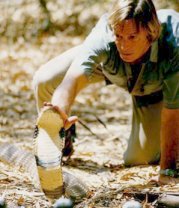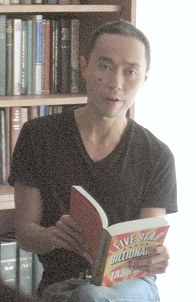So here's a bowl of home-made ginger milk curd.

The surface is a little pockmarked because of air bubbles from stirring
the milk with a whisk; perfectionists eyeing a smooth alabaster surface
can use a wooden spoon - and slower movements
the milk with a whisk; perfectionists eyeing a smooth alabaster surface
can use a wooden spoon - and slower movements
This is the trickiest thing I've made so far. They key to the success of this dessert lies in the ginger and the temperature of the milk. Too hot or too cold and the milk won't congeal into the custard-like consistency you want in an almost magical process that involves the enzyme zingipain, found in ginger.
Old ginger root, which has a very fibrous core, is recommended, as it's said to be richer in the enzyme; if the ginger is too young or soft, the fibres are finer and fewer and you'll have to use more of it.
So far, only two out of my seven or eight attempts at this dessert were successful. Other times, all I got was ginger-flavoured milk which is also good, but not what I was aiming for.
All I do is heat the milk to a boil, then turn down the heat and let it simmer. I sweeten it with honey, resisting the urge to use any kind of cane sugar - which they say we're having too much of, whether brown or 'organic'. No exact measurements for the honey - I just add and stir until the colour's to my liking.
Because the ginger I currently have can be considered young, I grate a whole pile of it (maybe four to five inches worth) before the milk goes into the saucepan. While the milk is heating up, squeeze the ginger juice over a strainer or sieve into a bowl or mug, and set it aside.
When it's time to pour the milk, give the ginger juice a stir. If the juice has been sitting there for a while, you might find a layer of what feels like chalk or powdered starch at the bottom. Stir this up so that it mixes with the juice; one or two recipes says this helps the curdling process.
I then turn off the heat and let the milk cool a bit before pouring the milk into the bowl with the ginger juice. Then I leave it alone. This is another stage where the recipe tends to fail. Some recommend a temperature of between 40°C and 70°C, but this is cooking, not science. Just make sure the milk isn't boiling when it's time to pour.
Though a lot of recipes say the milk will congeal within three minutes, but I tend to set it aside for a little longer (up to ten minutes). I also keep it covered with a small dish or saucer to keep the heat in - and the creepy crawlies out.
I'm not the type who often experiments with various milks, so I stick with the ingredients that I've been successful with: full cream milk (none of that UHT stuff, that's milk-flavoured water), honey, ginger, and maybe a little prayer for success. But the grating - oh g*ds, the grating.
I might have to use a different ginger root, however.
Some additional points:
- I don't grate the ginger or extract the juice and store it for later use. Ginger has quite a few enzymes and they might degrade with time. It's better to grate and squeeze it fresh. The milk can simmer for a bit longer while you do it, and it'll thicken, which means a creamier curd.
- If it fails, don't rescue it with more ginger juice, additional heating, or both. You're likely to end up with a partially curdled mess that might not taste good, as I did once. Let the failure cool, drink it up, and try again next time. But my refusal to admit defeat one evening led me to drink about a litre of failure.
- If you're making multiple servings, keep at least one in the fridge to cool. It'll taste even better.
- Resist the urge to throw in flavours like vanilla extract, coffee or pandan, as it might mix with the ginger and produce a not-so-ideal taste. ...Okay, maybe pandan might be worth a try.
'k, good luck.
Categories:
Epicurean Editor



















































